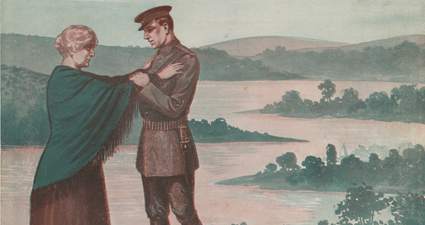 The Irish experience during World War I (1914-1918) was complex, and the variety of Irish and Irish American themes in popular sheet music of the era reflects this complexity. These themes include romantic songs, songs honoring military units, patriotic songs, and songs reflecting Irish politics of the time.
The Irish experience during World War I (1914-1918) was complex, and the variety of Irish and Irish American themes in popular sheet music of the era reflects this complexity. These themes include romantic songs, songs honoring military units, patriotic songs, and songs reflecting Irish politics of the time.
During the World War I years of 1917 to 1919, the U. S. Government requested that industries using consumable products begin to conserve these materials -- including paper goods. A smaller 7” x 10” sheet music format was introduced by some publishers, shrinking the cover art and even condensing multiple pages of music. Examples from our collections of World War I songs published in this smaller format include "An Irishman Was Made To Love and Fight" and "K-K-K-Katy."
George M. Cohan and “Over There”
In 1917, Irish American George M. Cohan wrote the song that would make him an international name. "Over There" was written while Cohan was riding on a train to New York after hearing the news that America had entered the Great War. The song became a smash hit and quickly sold over a million copies. It became the rallying song for American troops and to this day is the one song most Americans associate with World War I. Twenty-five years later President Franklin D. Roosevelt would present to Cohan the Congressional Medal of Honor for the uplifting spirit it brought to American troops.
“It’s a Long, Long Way to Tipperary”
“It’s a Long, Long Way to Tipperary” (also known as “It’s a Long Way to Tipperary”) actually predates World War I, although it became popular and associated with the war. Originally a British music hall song written by Jack Judge and co-credited to Harry Williams, journalist George Curnock reported that the Irish regiment of the Connaught Rangers sang the song as they marched through Boulogne on August 13, 1914. Other British army units picked up the song quickly thereafter. John McCormack, the famous tenor, recorded “It’s a Long, Long Way to Tipperary” in November 1914 which helped increase its popularity.
Other composers cashed in on this popularity by writing other “Tipperary” themed World War I songs: “I’m a Long Way From Tipperary,” “I’m Going Back to Tipperary,” and “It May Be Far To Tipperary It’s a Longer Way To Tennessee” are a few examples.
Ireland, Home Rule, and the Great War
A major political crisis over Home Rule or Irish self-government occurred before the outbreak of the First World War. The Third Home Rule Act was signed into law in September of 1914, although operation of the Bill was suspended during the war. The start of the war in 1914 temporarily defused armed tensions between Unionists and Nationalists. A total of 206,000 Irish served in the British forces during the war.
The participants of the 1916 Easter Rising sought and received aid from Germany during the war. However, the shipment of arms was intercepted and destroyed off the coast of County Kerry by British forces before the uprising began.
This all led to the creation of songs such as "Volunteer March - Song" and “When Germany Licks England Old Ireland Will Be Free” by Charles A. Meyers in 1915, which was published in Kenosha, Wisconsin. Interestingly enough, Meyers also wrote “We’re Going to Show the Kaiser the Way to Cut Up Sauerkraut” later in 1918.